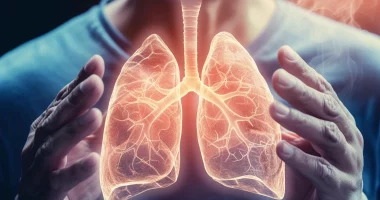Ankylosing spondylitis
What does ankylosing spondylitis mean?
Bekhterev’s disease (ankylosing spondylitis) is a chronic, non-infectious disease of the spine joints and periarticular tissues with involvement of the sacroiliac joint.
About the disease
Bechterew’s disease is associated with the carriage of the histocompatibility antigen HLA-B27 and belongs to the group of seronegative spondyloarthritis (inflammatory lesions of the joints of the spine).
As a rule, the first manifestations of the disease occur at a young age (15-30 years) and are rarely observed after 45 years of age. In women, the first radiologic changes appear much later than in men. The onset of the disease at a young age and early disability determine the particular urgency of the disease.
Ankylosing spondylitis presents certain difficulties for early diagnosis. On the one hand, this is due to poorly expressed symptomatology, and on the other hand, due to the clinical diversity of the debut of Bechterew’s disease. The disease may manifest not only with pain in the lower back but also with peripheral arthritis, inflammatory lesions of tendons, or the vasculature of the eye. The main radiologic criterion, reliable sacroiliitis, is often absent in the early stages of the disease. Therefore, according to international protocols, advanced diagnostics are performed to establish an accurate diagnosis.
Treatment is carried out by conservative and surgical methods. The stage of the disease determines the choice of treatment tactics.
Types of Bechterew’s disease
The juvenile form of ankylosing spondylitis, which develops in children and adolescents, is singled out in a separate category.
The following types of Bechterew’s disease are also distinguished:
- Central – only the vertebral column is involved in the pathological process.
- Peripheral – more common in adolescence, the sacroiliac and other large joints are the first to suffer; the spine remains intact for a long time.
Symptoms of Bechterew’s disease
The disease begins gradually, usually at the age of 15 to 30. The main sign of Bechterew’s disease is a bilateral inflammatory lesion of the sacroiliac joints. Therefore, the main symptoms of Bechterew’s disease are:
- pain in the sacral and lumbar region, as well as on the posterior surface of the thigh, which at the initial stage resembles a pinched sciatic nerve;
- pain sensations are constant; the intensity increases significantly in the second half of the night;
- compensatory tightness of the buttock muscles may progress to atrophy over time.
In addition to sacroiliitis, an essential manifestation of Bechterew’s disease is stiffness in the lower back, which is accompanied by painful sensations. Gradually progresses immobility of the lumbar segment of the spinal column. Objective examination reveals smoothness or complete absence of the lumbar curve of the spine.
The disease usually begins with lesions in the sacral-lumbar region. Gradually, the pathological process progresses and involves the thoracic spine. At this stage, chest pain appears, which spreads through the intercostal spaces. Ankylosing spondylitis in the thoracic region also damages the articulations between the ribs and sternum, which reduces the mobility of the chest when inhaling and exhaling.
If the disease is not treated, then over time, the pathological process also affects the cervical segment of the spinal column. At this stage, the patient notices that it is difficult to turn his head to one side or another, which is associated with the developing limited mobility of the joints. When tilting the head, the person cannot reach the sternum with the chin.
Although Bechterew’s disease was initially thought to be exclusively a disease of the spine and perivertebral tissues, it was later found that the autoimmune process can also affect large joints, particularly the hip and shoulder, and sometimes smaller peripheral joints. Involvement of these joints also develops gradually and, in the final stage, leads to fusion between the bony ends involved in the formation of the joint (ankylosis). The involvement of large joints in Bechterew’sdisease is always bilateral, emphasizing the systemic nature of the autoimmune lesions.
Bechterew’s disease has a variety of clinical symptoms. In addition to bone and joint manifestations of the disease, the following conditions are possible:
- Inflammatory damage to the structures of the eye – uveitis – may be the first manifestation of the disease; the iris and the ciliary body may also become inflamed;
- Inflammatory damage to the myocardium and/or pericardium with the development of cardiac arrhythmias, heart pain, and edema;
- Inflammatory lesion of the lung tissue, which is accompanied by coughing and shortness of breath;
- Autoimmune kidney damage that leads to the deposition of amyloid protein (renal amyloidosis).
Causes of Bechterew’s disease
The causes of Bechterew’s disease have not been definitively established. The disease is believed to be an autoimmune process that develops when carrying the histocompatibility antigen HLA B27. Recently, there has been emerging work that indicates that certain strains of Klebsiella and other species of intestinal bacteria may be the trigger of pathogenesis. It is believed that the antigens of these microorganisms have similarities with HLA B27, which causes a prolonged and monotonous persistence of infection in the body, which initiates an autoimmune response.
Diagnosis and clinical guidelines for Bechterew’s disease
Diagnosis of Bechterew’s disease is aimed not only at assessing musculoskeletal damage but also at determining the degree of activity of the inflammatory process. The examination program may include the following methods:
- Radiographic evaluation of the sacroiliac joint and the joints of the spine;
- A general clinical blood test to assess erythrocyte sedimentation rate;
- determination of C-reactive protein levels in plasma;
- laboratory determination of the concentration of circulating immune complexes in the blood.
Radiography can detect the disease at the stage when there is a lesion of the sacroiliac joints. Therefore, according to clinical guidelines for Bechterew’s disease, the initial stages of the pathological process are not identified on radiographs. For early diagnosis, magnetic resonance imaging is the most informative. It allows detecting pathological changes not only in the sacroiliac joints but also in the hip joints.
Differential diagnosis of the disease is carried out at an early stage with psoriatic and reactive arthritis and radiculopathy.
Treatment methods for Bechterew’s disease
Treatment methods for Bechterew’s disease are divided into conservative, which is most appropriate in the early stages of the disease, and surgical, which is indicated when bone deformities develop.
Conservative treatment
The main objectives of conservative treatment are:
- complete elimination or significant reduction in the intensity of pain syndrome;
- improved mobility in the spine;
- reducing the severity of muscle fatigue;
- increasing the functional capacity of the spine;
- slowing down structural changes.
The main directions of the conservative approach in the treatment of Bechterew’s disease are:
- Taping. Properly applied taping can reduce the load on the spine and activate diaphragmatic breathing.
- Therapeutic physical therapy. A rehabilitation doctor develops a complex of exercises. The specialist compiles training that involves the performance of smooth movements with a dosed load. Swimming has a perfect effect on the condition of the spine.
- Drug therapy. The first line of drugs – these are nonsteroidal anti-inflammatory drugs that allow you to control pain (block pro-inflammatory prostaglandins). If therapy is ineffective, corticosteroids are prescribed. In severe cases, cytostatic drugs, inhibitors of interleukin 17, and tumor necrosis factor type alpha may be indicated. Myorelaxants are used to reduce muscle spasms.
Surgery for Bechterew’s disease
Surgery for Bechterew’s disease is recommended when the hip joints are affected with a tendency to develop ankylosis (third stage of functional joint insufficiency). The scope of surgical intervention consists of hip joint replacement.
All these treatment options are available in more than 830 hospitals worldwide (https://doctor.global/results/diseases/ankylosing-spondylitis). For example, Total hip replacement (Unilateral) can be done in 24 clinics across Turkey for an approximate price of $12.6K (https://doctor.global/results/asia/turkey/all-cities/all-specializations/procedures/total-hip-replacement-unilateral).
Prevention of Bechterew’s disease
Specific prevention of Bechterew’s disease has not been developed. The timely treatment of infections, the fight against hypodynamia, and regular exercise that strengthens the spine are of particular importance.
Rehabilitation for Bechterew’s disease
Rehabilitation in Bechterew’s disease after surgery is reduced to timely restoration of the function of the operated hip joint. For this purpose, courses of physiotherapeutic procedures, massage, and physical therapy exercises (under the supervision of a specialist in physical therapy) are recommended.
Immediately after surgery, the operated leg should not be subjected to physical activity for several days. During this time, walking on crutches is recommended. After the doctor’s approval, you can walk with the lower limb, resting on the lower limb and gradually recovering it.


